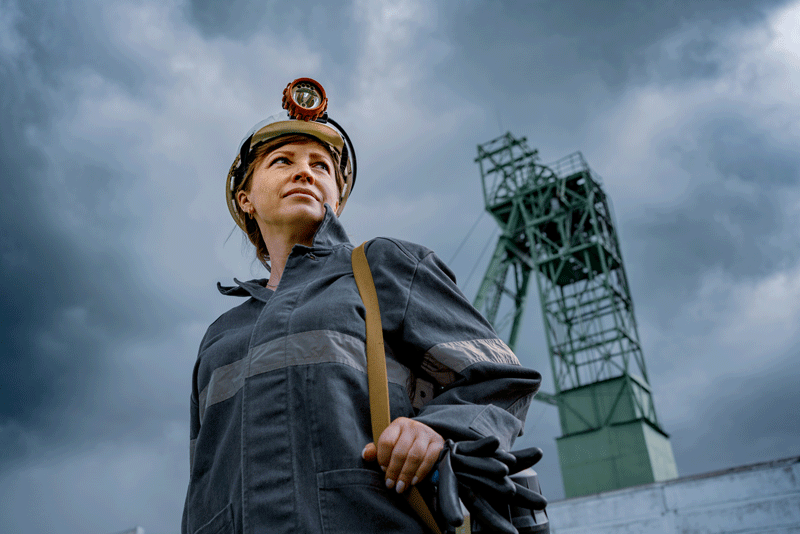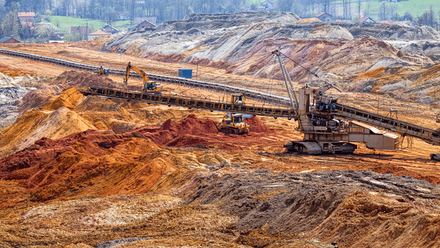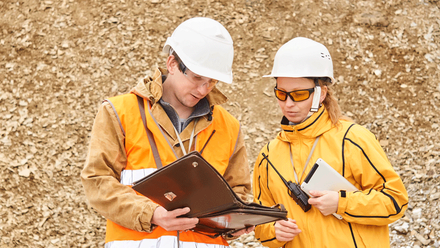Tapping into talent - women in mining
A recent online event explored the points of resistance for women at each stage of their mining career and the available opportunities to thrive. Alex Brinded reports.

‘Keep in mind, mining shares a labour pool with other industries, and, in some instances, the pool is much too small to support any of these industries, including the mining industry. So, this means that all industries drawing on that labour pool are going to be behind,’ said Jamie Wolcott, Director of Labour Market Information at the Mining Industry Human Resources Council, at a recent webinar on ‘Women in Mining’ run by Edumine, a training provider for the mining sector.
Wolcott pointed to the Canadian minerals and metals plan, which aims for 30% women in mining by 2030, nearly double what it is currently. ‘And yet we have not really seen much improvement historically, or at least it has been rather slow. According to the Labour Force Survey, we have the average representation going up about 3% over the last decade. So, the question is, why is this such a hard thing to move from?’
Wolcott drew two conclusions. ‘First, we did not necessarily lose women when they were picking their industry, we lost them when they were picking their occupation. So, in this case, what may look like an issue for the mining industry is actually something much broader. Second, it does not matter if we outcompete other industries if the underlying labour pool is too small and knowing this can certainly inform our strategy for how we are going to overcome this…The ideal approach will vary by occupation.’
Simon Gillibrand, Global Head of Natural Resources at recruitment agency CSG Talent, suggested that there was an opportunity for mining to better align with younger worker’s values. He said, ‘If you can decarbonise the mining industry…the attraction is a skillset for people who want to make a difference in the world. The mining industry is now being seen as an opportunity to have an influence.’
Monica Moretto, Vice President of Sustainability, Diversity and Inclusion at the Canadian miner Pan American Silver Corp, also lamented the lack of female representation in the sector. ‘If our retention packages and our retention practices are optimal, it will [increase by] word of mouth. People that are happy and women that are happy working in the mining industry will [feed] back to others…We hear about people working in tech companies raving about it and how they love the environment. We barely hear talk about people who love working in the mining industry.
‘Close to 75% [of the workforce] will be millennials, and they are the people that we need to appeal to. The way mining works right now is not appealing to them.’
The art of belonging
Andrea Carter, a Toronto-based consultant, conducted a study of 13 TSX-listed mining companies and over 3,500 employees. She found the entry-level positions were predominantly held by women, while technical operators and middle-management roles had the lowest numbers.
She notes, ‘Meta analysis of ‘belonging’ indicates that it is the highest predictor of engagement, job satisfaction and motivation for talent. The predictors of belonging within the mining industry research are gender, ethnicity and career level. The statistical significance points to creating a culture of belonging as a means to grow the industry and a means to restabilise talent growth.’
Daniella Dimitrov, President, CFO and interim CEO at Canadian gold miner IAMGOLD, discussed the barriers she had faced. ‘Some of the challenges…are more the subtle things – being interrupted all the time; having people finish one’s sentence; having people talk about your views while you are right there rather than expressing your own views; not being heard, not being listened to; expressing a viewpoint around a particular topic that falls on deaf ears and someone else expressing the same viewpoint two minutes later and it being a fantastic idea. [These] really all contribute to feeling like you do not belong in this industry…There should be a safe space that you create for everybody to express their viewpoint.’
Answering a question about Rio Tinto’s recent report mentioning sexual harassment, Moretto said, ‘So this happens in every industry, this does not only happen in mining. What happened is Rio Tinto were brave enough to tell the truth about what is happening in their workforce.
‘What will make the difference are real zero-harassment policies internally in companies, real limitations and real belief that we have internal grievance systems that are strong.’
Dana Pray, Principal at Pray & Company, Canada, a mining and green energy recruiter, said, ‘We are seeing some success, we are seeing those numbers [in leadership positions] come up slightly. In our case, it is telling other women that it is doable, and exciting, and also getting in front of the leadership in mining companies to explain the simple [changes needed] like facilities.
‘…Making sure the benefits align to what is important to those [millennial and Gen-Z] generations. In particular, women in those generations. Women who are raising families can [also] have a career in mining...if the leadership looks with a little broader mindset at how to make it easier for them…It does not have to be the good ol’ boys club anymore.’
Championing capabilities
Dimitrov notes the importance of women championing other women, and asked, ‘How do we think about talent in a different way…capabilities versus only experience? Because if we think about how we attract talent, how we develop talent and how we succession plan for talent we might open different opportunities in our industry…we could really accelerate the promotion of women.’
Moretto added, ‘Every single promotion that I have seen is sponsored by someone or by a group internally within a company. And it comes naturally, it is a combination of talent and sponsorship.
‘We are trying to get a more gender-neutral industry, but at the same time that won’t happen until we start to work together and understand that we are different, and it is okay to be different.’
The chair of the event, Akua Serwaa-Sarfo from the Northern Miner Group, UK, quoted from a 2021 article from the consultants Mckinsey titled, Why women are leaving the mining industry and what mining companies can do about it, which ‘talked about how the drop-offs from entry level to executive for females in mining is among the most drastic across all industries that they have studied’.
Gillibrand said, ‘We need to encourage female members to go for promotions, and this is not just down to female leaders to support, but male leaders too...Put people forward, encourage them. Often females have taken different routes to their leadership roles, it is not just ABCD, they could go here and here, but often we get from our clients ‘we need someone who has done ABCD’, so it is educating them to open up.
‘When we are seeing those internal promotions and those review boards, there is a bunch of middle-aged white men judging on it. Again, language used in the job descriptions, looking to get diverse interview panels and encouraging people to go for those promotions to stop the drop-out rate.
‘People are leaving the industry, getting all that experience and moving to industries where they are offering more flexible working and offering all these other things that the mining industry has not caught up on.’
Dimitrov also called for an appreciation of how people differ. ‘There’s a great quote by Sir Richard Branson, along the lines of, if somebody offers you an opportunity and you do not feel you are qualified for it, put up your hand, take it and figure it out later...I know a lot of women that feel that they have to have 150% of qualifications for a particular role, for them to put up their hand and say I am going to apply for this particular job.
‘And we need to be attuned to that and...think about that in advancements, in promotions and in succession planning, because not everyone is the same…we should be watching out for and promoting them.’
New model
Carter felt that there was a wider cultural shift that needed to happen, ‘If we want to attract, retain and create a sustainable talent pipeline, companies need to understand the impact of micro-aggressions, racism and discrimination, and then create behaviours and metrics that counteract their occurrence.
‘Employees need to experience belonging from the onset of recruitment, through organisational culture and it needs to be communicated by leadership on an ongoing basis. And there needs to be metrics that continue to govern that progression.’
She continued, ‘Let us face it, equity, diversity and inclusion is a billion-dollar industry and has been for over 10 years. The only reason it is not moving the dial is because we are not looking at it through a lens of what it is that we want to see versus what we are scared to see. And I think when it comes to even looking at Rio Tinto’s fantastic paper – they understand that what is not measured does not change.
‘So, we [need to] start having organisations reveal the data and the baseline elements that are not pretty and that are not okay. It does not mean that these companies are bad companies. It means that the companies have growth and opportunities and areas for improvement. But until they recognise where they have those lower metrics and numbers, they cannot change what they are seeing, and the industry will continue to struggle to attract more people into it.’



